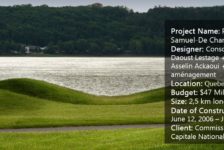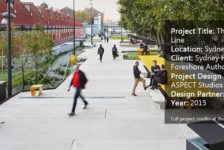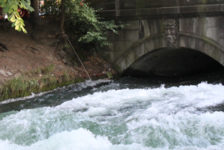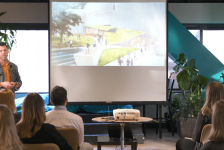An Interview with talented plantsman Adam Woodruff. Let yourself be fascinated by planting design, and discover a particular discipline that is very important for landscape architecture practice. This specialized area of landscape architecture includes plant selection ability and horticultural knowledge about the growth requirements of plants, but also a visual touch. Adam Woodruff, owner and founder of Adam Woodruff + Associates, is a young, talented plant designer based in Clayton, Missouri, who is starting to affirm a new view of visual and botanical attention in planting design.
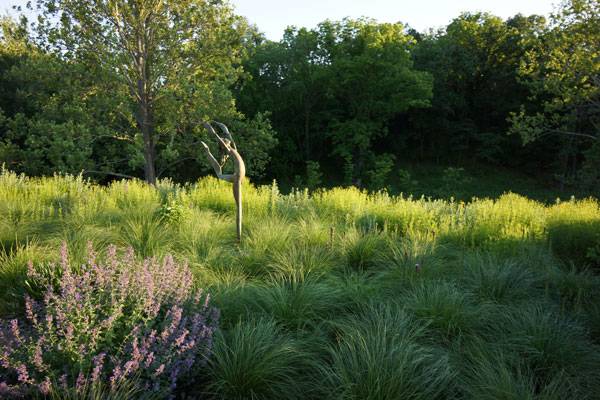
Photo courtesy of Adam Woodruff
Woodruff shares with us his knowledge and his approach as a plant designer. Here you can find some information about his practice and advice to help you be a better landscape designer.
Interview with Adam Woodruff

Adam Woodruff
During concept creation, how long do you spend imagining the design directly on the site? And how long do you spend contemplating solutions in the studio?
Woodruff: I don’t like to rush concept development. It’s a time to dream and to contemplate the possibilities. I am very visual, so I spend a considerable amount of time on site early in the design process. I work for the organization of space, flow through the garden, views, and screening, etc.Later, in the studio, I develop preliminary ideas more fully. I am frequently back and forth to the site, verifying concepts before presenting them.
LAN: What are the most important things to choose and match in working with such different plant species as you do?
Woodruff: For successful plantings, always consider the cultural requirements of the plants you are combining.
LAN: What are the benefits of using tropical plants in your projects?
Woodruff: I use tropical plants and seasonal annuals to ensure continuous bloom.Typically, they offer strong architectural forms and bring a unique presence to the garden.
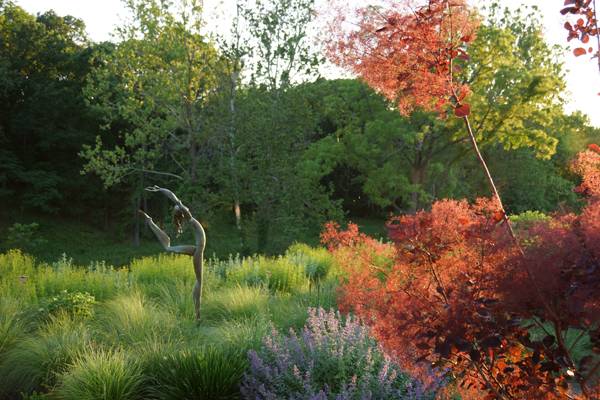
Photo courtesy of Adam Woodruff

Photo courtesy of Adam Woodruff
- Cardoon (Cynara cardunculus)
- Canna lily (Canna spp.)
- Elephant ear (Alocasia spp., Colocasia spp.)
- Terrestrial bromeliad (Aechmea spp., Hohenbergia castellanosii)
- Castor plant (Ricinus communis)
- Banana (Musa spp., Ensete maurelii)
- Mother-in-law’s tongue (Sansevieria spp.)
- Coleus (Solenostemon scutellarioides)
- Croton (Codiaeum spp.)

Photo courtesy of Adam Woodruff
This year, you won the
Gardenista Considered Design Awards as the
Best Professional Landscape for the “Jones Road” project. How did you choose those perfect color combinations to get that extraordinary natural visual result?
Woodruff: The garden was designed in 2008 as a block-style planting. It was my first foray into a large-scale perennial garden design. Initially, the palette was inspired by Piet Oudolf’s Lurie Garden at Millennium Park in Chicago, but the plants were arranged differently.

Photo courtesy of Adam Woodruff
Since then, I have evolved as a designer, largely influenced by travels to Europe to visit significant gardens and their designers. Jones Road served as a trial ground. The garden has become an intermingled planting with fewer blocks of perennials. While color plays a role in plant selection, it is only one of the criteria.
LAN: How have
Piet Oudolf and Roy Diblik inspired you and your practice?
Woodruff: I first met the pair in 2009. Roy, during the summer in St. Louis, Missouri, at the Perennial Plant Association’s annual conference and Piet, later that fall, in the Netherlands during an open day at his private garden. These early interactions sparked a creative awakening in me. I realized my work could be more.
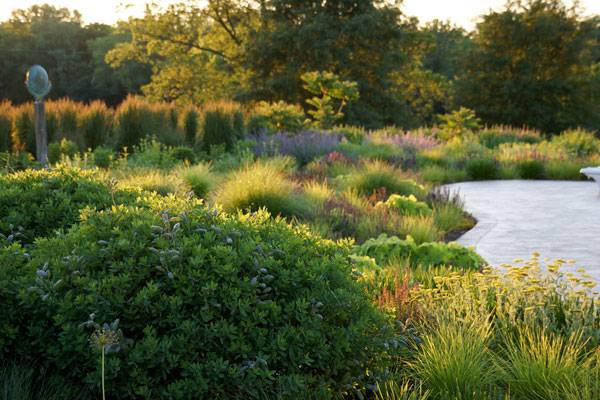
Photo courtesy of Adam Woodruff
is a master at creating atmosphere, evident in all of his works and exemplified at his private garden in Hummelo. It’s an ethereal place! I was so moved by my visit in 2009, I’ve returned four times since. I’ve visited most of his other gardens in an effort to connect with the underlying emotional resonance in his work. Piet creates living, dynamic art! His evocative planting schemes are aspirational to me.

Photo courtesy of Adam Woodruff
is a brilliant plantsman. During the PPA conference, he shared his philosophy: a common-sense approach to planting design based on how plants are found in nature — growing together in communities that share similar habitat and cultural requirements. His designs are not only beautiful, they are practical models of sustainability, diversity, and low maintenance.
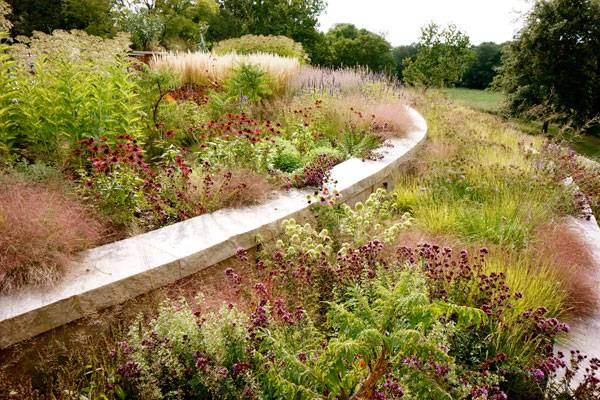
Photo courtesy of Adam Woodruff
Over the years, the pair have been open and very generous with me. We share a love of plants and beauty. While I continue to refine my style, I understand the importance of developing a signature independent of those who inspire me.
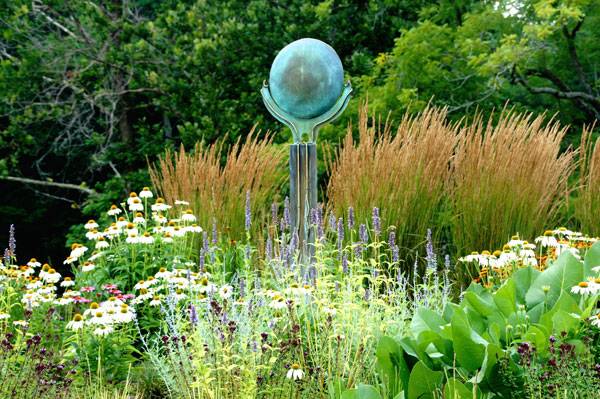
Photo courtesy of Adam Woodruff
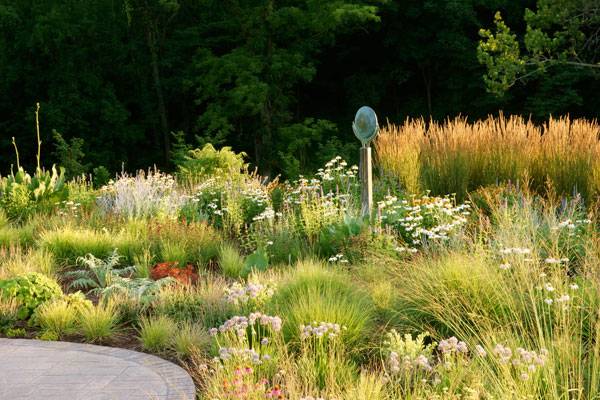
Photo courtesy of Adam Woodruff
Do you design your garden already thinking to its dynamic nature and all changes that will come in following years?
Woodruff: My design solutions are intuitive, heavily plant-based. They are built over several seasons. I start with a good base layer, (and) add enhancements to create more visually dynamic displays with a good bloom succession, diversity, and seasonal interest. I am fortunate to have patient clients who support my experimentation and appreciate that building a garden is a process for me. I don’t know that I’ll ever be able to put it all on paper and pass it off to an installer.
LAN: What are three of the biggest mistakes you see in large scale planting plans today?
Woodruff:
- Designing the macro experience while overlooking the micro experience, or vice versa. Gardens need to be legible from a distance, and sufficiently interesting up close and personal.
- A lack of diversity.
- The use of hardwood mulch. Roy Diblik has been a long promoter of leaf compost as an alternative for healthier perennials. He points out that in nature, perennials and grasses grow in their own debris, not surrounded by wood mulch.
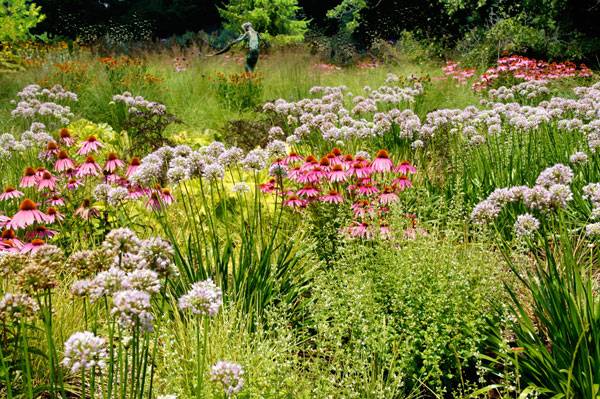
Photo courtesy of Adam Woodruff
In your experience, who is the perfect client and who is the worst?
Woodruff: There is no perfect client. While unlimited budgets and complete creative control are nice, working with constraints is more often the reality. Challenging clients and situations present opportunities for growth. Trust your instincts, particularly when interviewing a potential client. Successful relationships are built on mutual respect and trust, and some relationships just require more attention than others.
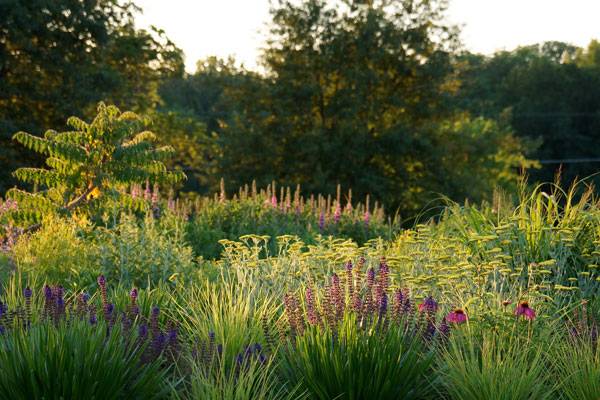
Photo courtesy of Adam Woodruff
Have you ever had problems with maintenance that changed your project once it was finished?
Woodruff: Early in my career, I designed, installed, and maintained a large and elaborate garden that received a fair amount of attention. At the request of the client, the garden was to include significant seasonal color. I wove annuals and tropicals between perennials, ornamental grasses, and shrubs. The seasonal components were redesigned each year. It was a very high-maintenance design.

Photo courtesy of Adam Woodruff
In 2010, we moved from St. Louis to the East Coast. I hadn’t considered that one day I might not be involved with the project. I’m less than satisfied with how the garden looks today. This has led me to rethink how I design. I’m much more interested in creating gardens that live beyond my involvement.
LAN: If somebody wanted to follow in your footsteps, what advice would you give them?
Woodruff: There is nothing formulaic about my career trajectory. Serendipity continues to play a major role.
Some pointers I’ve learned along the way:
- Follow your passion.
- Be curious.
- Travel to see gardens beyond your region.
- Don’t compromise artistic integrity — you’ll regret it later.
- With each new project, experiment and take some controlled risks.
- Have a trial garden.
- Know your strengths and play to them. We can’t be good at everything. Collaborate when necessary. If business is not your forte, hire a consultant and a good accountant.
- Build your business on referrals, not advertising.
- Never forget that you are the brand.
- Join a professional trade organization.
- Identify a mentor.
- Network with other designers and gardeners whose work you admire.
- Network with professionals in adjacent industries — architects, interior designers, etc. They are a great source for referrals.

Photo courtesy of Adam Woodruff
If you could recommend just one book on plants, what it be and why?
Woodruff: With so many plants, recommending just one book is impossible. Some of my favorite resources include:

Photo courtesy of Adam Woodruff
What’s next for you? What else are you currently working on?
Woodruff: At the moment, I’m installing a two-acre landscape and gardens for a new home in Ladue, Missouri. The client is a young couple with small children. The design compliments the home’s French-style architecture without being too fussy. The aesthetic is soft and naturalistic juxtaposed with formality: clipped hedges and patterned repetition of structural elements like trees and shrubs.

Photo courtesy of Adam Woodruff

Photo courtesy of Adam Woodruff
Also, I’ve recently taken on an exciting (and challenging) new commission in South Texas, designing the landscape and pleasure gardens for a 19-acre estate. Thank you so much to Adam Woodruff for sharing his knowledge and giving us some new interesting tips in planting design. You can find more information about Woodruff’s projects at
www.adamwoodruff.com. Interview conducted by Maura Caturano
Return to Homepage
Published in Blog




















